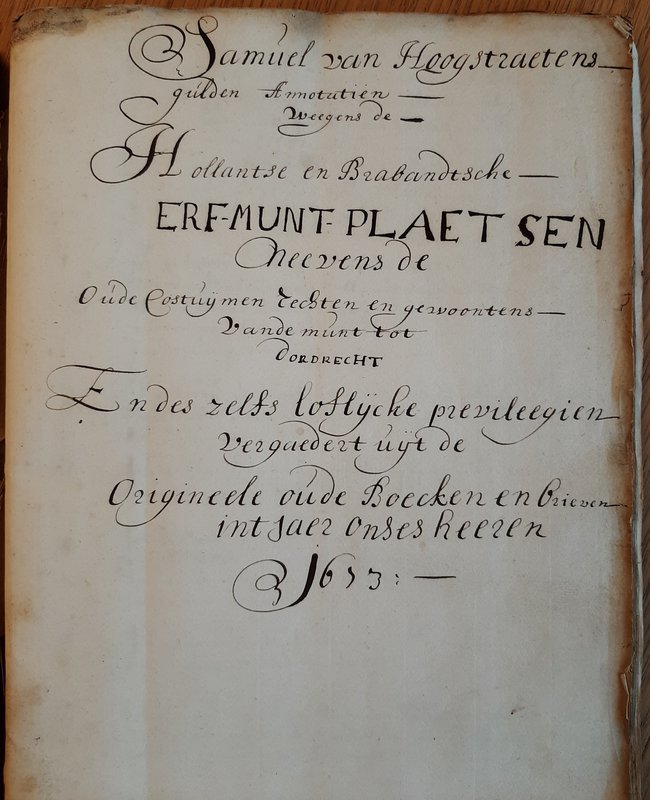Final Years in Dordrecht
In March 1671, notary Johan Cop, brother-in-law of Van Hoogstraten’s wife, Sara Balen (d. 1678), passed away in Dordrecht. This prompted Van Hoogstraten to return to Dordrecht and, six months later, he purchased Cop’s widow’s house on Steegoversloot (at the location of modern-day no. 21). It was recently discovered that, in 1674, Van Hoogstraten received a tax assessment there of ten guilders for his (rather low) estimated fortune of two thousand guilders.1
In Dordrecht, Van Hoogstraten took on pupils, including his later biographer Arnold Houbraken (1660-1719) and probably his nephew Anthony de Vos. From 1673, he also managed affairs for the Mint of Holland in the capacity of governor, and conducted research. A copy of his Gulden Annotatiën (Golden Annotations) has survived [14].2 In 1675, the fence of the Minters’ Chapel in the Church of Our Lady in Dordrecht was restored and, to mark the occasion, Van Hoogstraten wrote a chronogram. The fence carries his family crest. As Master minter, he and his wife had the privilege to be buried in this chapel, which still exists.3
From 1674, Van Hoogstraten seems to have made fewer paintings and more etchings. In 1677, he provided illustrations for his cousin Matthijs Balen’s history of the city of Dordrecht. In the final years of his life, Van Hoogstraten concentrated mainly on writing the Introduction to the Academy of Painting; or, The Visible World, his magnum opus, which was published a few months before his death in 1678. It includes a self-portrait of Van Hoogstraten writing [15]. If anything in Van Hoogstraten’s oeuvre can be called grand, it is this volume, which consists of nine chapters, each dedicated to one of the classical muses.4 Each chapter begins with an allegorical depiction of a muse, designed and etched by Van Hoogstraten himself, as well as two poems: one on the content of the chapter and one explaining the depiction [16].5 The Introduction to the Academy of Painting; or, The Visible World not only confirms Van Hoogstraten’s high status as an artist, with an oeuvre of over five hundred paintings, drawings and etchings, but also his high social rank as a learned and distinguished man.

14
Samuel van Hoogstraten, 1673
Gulden Annotatiën weegens de Hollantse en Brabandtsche erf-munt-plaetsen (…)
title page of a contemporary copy Regionaal Archief Dordrecht, Dordrecht Collection Family Repelaer van Spijkenisse, inv. 589.

15
Samuel van Hoogstraten
Self-portrait of Samuel van Hoogstraten (1627-1678), dated 1677
The Hague, RKD – Nederlands Instituut voor Kunstgeschiedenis (Collectie Iconografisch Bureau)

16
Samuel van Hoogstraten
Erato, the muse of poetry, before 1678
The Hague, RKD – Netherlands Institute for Art History
Notes
1 National Archives, The Hague, access 3.01.28, inv. 13 (Quohier vanden 200e penning over de stadt Dordrecht/Assessment Register of the 200th Penny [Levied in] the City of Dordrecht), fol. 82v (for the painter Jacobus Leveck, see fol. 67r: ‘in the inventory of his Uncle Wouter Boucket’ with the same tax assessment).
2 S. van Hoogstraten, Gulden Annotatiën weegens de Hollantse en Brabandtsche erf-munt-plaetsen neevens de oude costuijmen rechten en gewoontens van de Munt tot Dordrecht. En des zelfs loflijcke previleegien vergaedert uijt de origineele oude boecken en brieven int jaer onses Heeren 1673 (Handwritten copy after the lost original. RAD 1074, inv. 589).
3 Van Duinen 2014, pp. 248-249.
4 Maciesza/Runia 2025, pp. 30-31. One of the sons of Samuel’s brother Fransois referred to the Introduction as ‘an eminent book’. See Rutten 2005, p. 163.
5 Brusati 1995, chapter 6; Czech 2002, chapter 5.

